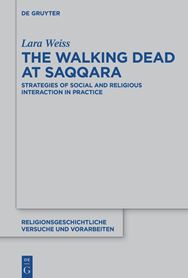
Гигантският некропол на Сакара с неговите пирамиди, гробници на фараони, аристократи и обикновени хора, с ежедневните тържествени заупокойни ритуали сякаш доминира безапелационно над древноегипетския град Мемфис. Но животът на древните египтяни със сигурност не се състои единствено от подготовка за отвъдното.
Настоящият том прилага към този проблем един новаторски, комплексен, мултидисциплинарен подход, който представя вярванията и ритуалите свързани със задгробния живот в светлината на цялостния социален живот. Според автора цялата подготовка за отвъдното приживе, погребалните ритуали при смъртта и последващият заупокоен култ са обвързани не само с въображаемото отвъдно и спомена за мъртвите, но и свързва индивида с обществото на живите, вписва го в неговата среда и определя както неговите функции като член на общността, така и мястото му в социалната йерархия.
Lara Weiss - The Walking Dead at Saqqara. Strategies of Social and Religious Interaction in Practice, Berlin - Boston, Walter De Gruyter, 2022 [Religionsgeschichtliche Versuche und Vorarbeiten 78] - на английски език, от De Gruyter, формат PDF. Сваляне с ляв бутон (downloading by left button) и после през бутона Download.
АЛТЕРНАТИВЕН ЛИНК / ALTERNATIVE LINK:
Lara Weiss - The Walking Dead at Saqqara. Strategies of Social and Religious Interaction in Practice, Berlin - Boston, Walter De Gruyter, 2022 [Religionsgeschichtliche Versuche und Vorarbeiten 78] - на английски език, от Google Drive, формат PDF. Сваляне с ляв бутон (downloading by left button) от страницата на предоставящия сървър, после през бутона стрелка надолу/after by down arrow button.
| 
